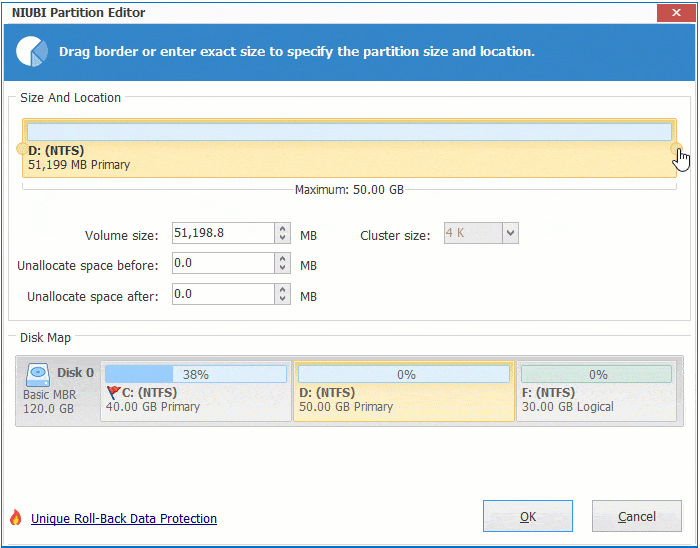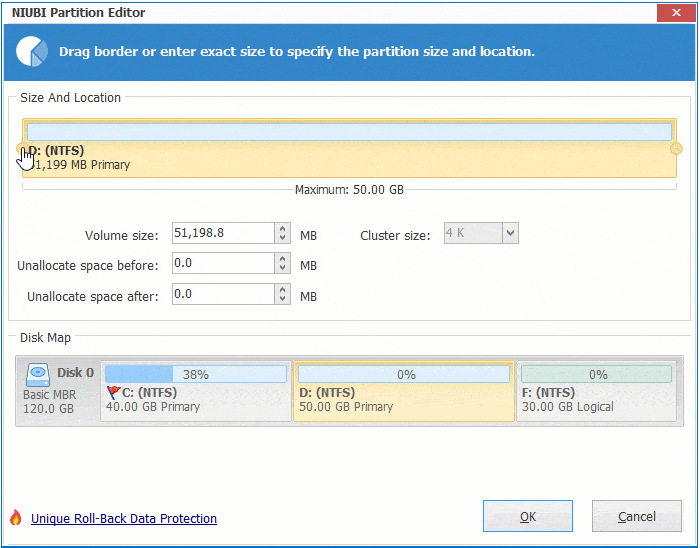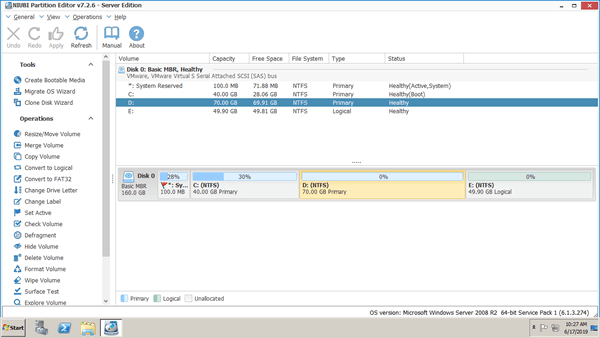When the system C: drive runs out of space, it can't be better if you can adjust partition size and extend C drive without losing programs and data. To help resize partition in Server 2008 R2 there's an inbuilt Disk Management tool. But because of many restrictions, it is not the best choice. Server partition software is much more powerful, but there's system damage and data loss risk. Therefore, you'd better make a backup in advance and run safe partition software. This article introduces how to resize partition in Windows Server 2008 R2 with both native tool and safe disk partition software.

1. How to resize Server 2008 partition without any software
Better than previous Server 2003, Server 2008 Disk Management has new functions to help resize partition. As the name, "Shrink Volume" is used to decrease partition size and release free space. "Extend Volume" is used to increase partition size with unallocated space. However, as I said in the beginning, this native tool has many restrictions.
Limitations to resize partition in Server 2008 r2 with Disk Management:
- It can only shrink and extend NTFS partition, FAT32 and any other types of partitions are not supported.
- It can only shrink a partition towards left and make unallocated space on the right.
- If there are unmovable files located in a partition, it can only shrink little space.
- It can only extend partition when there's contiguous unallocated space on the right side.
Many people encounter the issue that Extend Volume is disabled for C drive after shrinking D (or E) drive. This is because unallocated space that shrunk from D is nonadjacent to C drive. If you want to extend system partition C with Server 2008 Disk Management, the only option is deleting the contiguous D drive. Learn why Extend Volume greyed out in Server 2008.
How to resize partition in Server 2008 R2 with Disk Management:
- Press Windows and R together on the keyboard, type diskmgmt.msc and press "Enter" to open Disk Management.
- Right click a NTFS partition and select "Shrink Volume".
- Enter the amount of space and click "Shrink" button, if you do not enter an amount, all available space will be used by default.
- Transfer all files in the right contiguous partition (such as D:) to other place.
- Right click this partition (D:) in Disk Management and select Delete Volume.
- Right click the left contiguous partition (C:) and select Extend Volume.
- In the pop-up "Extend Volume Wizard" window, simply click Next till Finish.
If you want to resize FAT32 partition or extend a NTFS partition without deleting another one, you have to run third party disk partition software.
2. Best way to resize partition in Windows Server 2008 R2
Different with read-only program, partition resizing tool will modify the parameters of associated disk, partition and files. In some conditions, all files in the partition will be moved to new locations. If any software error or hardware issue happens, part of parameters will failed to be modified. In that case, your system, partition and files will be damaged. This is the reason why you'd better back up in advance and run safe partition software.
Better than other disk partition tools, NIUBI Partition Editor has advanced technologies to protect system, partitions and data:
- Virtual Mode - all operations you do will be listed as pending for preview, real disk partitions won't be modified until click "Apply" to confirm.
- Cancel-at-will - if you applied wrong operations, you can cancel the ongoing operations without damaging server.
- 1 Second Rollback - if any error is detected while resizing partitions, it automatically reverts server to original status in a flash.
- Hot Clone - copy disk partition without server interruption fast and easily.
Download NIUBI Partition Editor, you'll see the main window with disk partition layout and other information.
To resize partition in Windows Server 2008/2012/2016/2019/2022, you just need to click, drag and drop on the disk map. Right click a NTFS or FAT32 partition (such as D:) and select "Resize/Move Volume", you have 2 options in the pop-up window.
Option 1: If you drag right border towards left, or enter an amount in the box of "Unallocated space after", unallocated space is made on the right.

Option 2: If you drag left border towards right, or enter an amount in the box of "Unallocated space before", unallocated space is made on the left.

After getting unallocated space, you can create new volume or combine to other volume to increase partition size.
How to resize partition in Windows Server 2008 R2 without losing data:
- Follow Option 2 to shrink D: drive and make unallocated space on the left.
- Right click C: drive and select Resize/Move Volume again, drag right border towards right to combine this unallocated space.
- Click "Apply" on top left to execute. Watch the video how to operate:
- If you want to resize the nonadjacent drive E to expand C, there's an additional step to move unallocated space to the left before adding to C drive.
- Follow the steps if you want to extend D drive or other data partition.
- If you use any types of hardware RAID arrays such as RAID 1/5/6/10, there's no difference to resize RAID partition in Windows 2008 server.
3. How to adjust Server 2008 partition size with a larger disk
In few servers, the whole system disk is almost full. In that case, no software can add space to C drive from another separate disk. In that case, insert a larger disk to this server and then copy disk with NIUBI Partition Editor. Additional disk space can be added to C drive and other partitions. Follow the steps in the video to resize Server 2008 partition with another disk:
If system disk is full but there are other partitions on it, you may move one of the partitions to another disk. Then delete it and add its space to C drive.
4. Change partition size in Server 2008 R2 VMware/Hyper-V
If you run Windows Server 2008 as guest virtual machine in VMware or Hyper-V, firstly, check if there's plenty of free space on the same disk. If yes, follow the first video above to resize partitions. If there's no available free space on a disk, it is much easier to solve this problem. Unlike physical server to clone disk, you can expand virtual disk directly. Follow the steps:
After expanding disk, additional space is shown as unallocated at the end of disk. Then follow the steps to add unallocated space to C drive (and other partitions).
Besides resizing partition in Windows Server 2008/2012/2016/2019/2022, NIUBI Partition Editor helps do many other disk partition management operations.


